We do it daily: we ride our bike from home to work, to school, to the shop, to the dentist, to the gym, back home, and we park it at all of those places. But... do we also like the way we park it? Is it safe? Is it prone to damage? Will it get wet when it is raining? All of us are confronted with these questions when riding a bike. Let us explore where they lead us!
Innovative parking bylaws and (cargo) bike parking
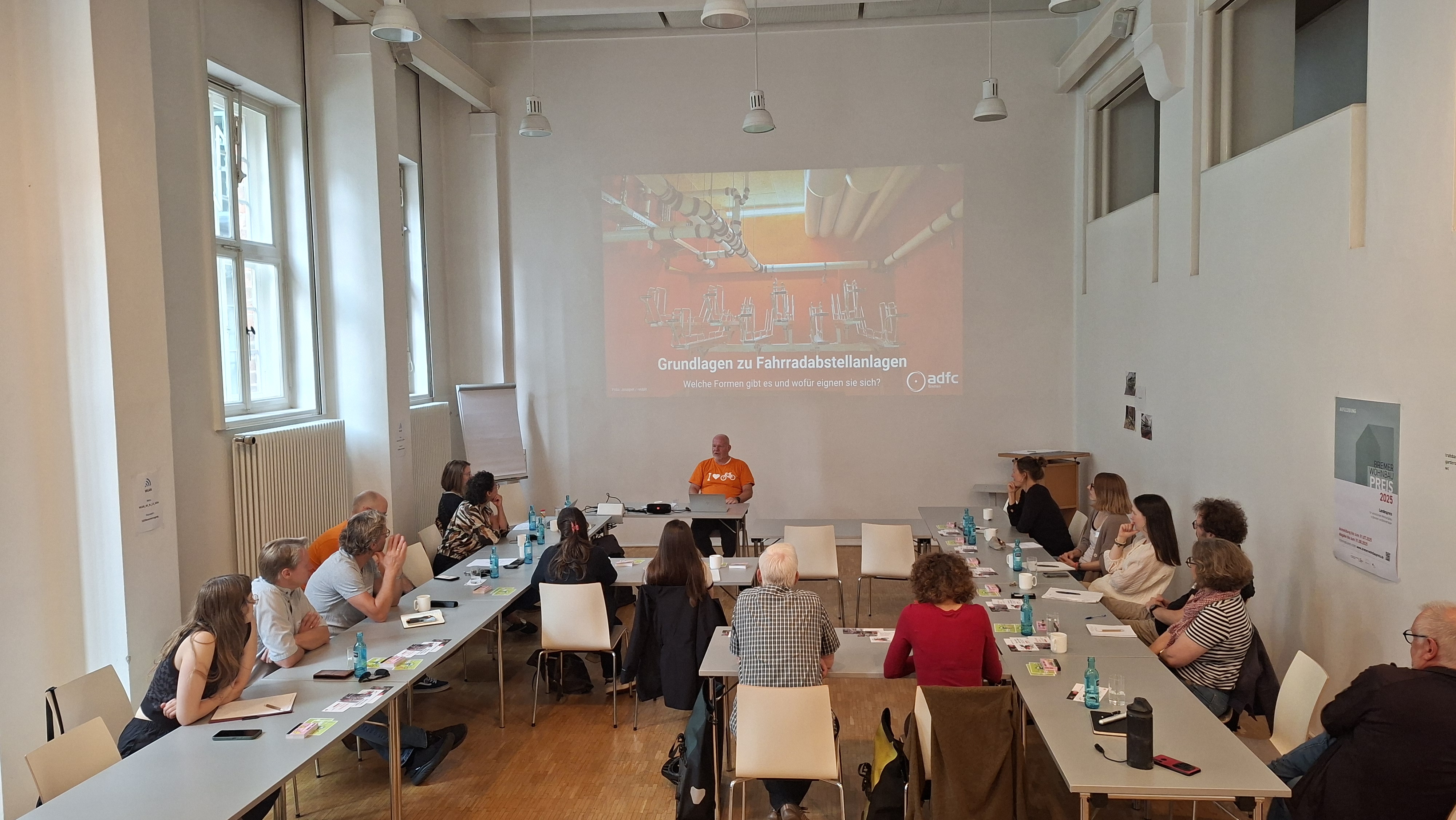
Diving into the theoretical world of bike parking
On the 3rd of September, the second edition of “The Do's and Dont's of (Cargo)Bike Parking” for planners and architects took place at the Chamber of Architects in Bremen—again framed by Bremen’s pioneering parking bylaw, the MobilitätsBauOrtsgesetz.
Our Bremen SN² colleagues Sarah König, Rebecca Karbaumer, Cornelia Cordes, as well as Sven Eckert and Stephan Glinka from ADFC Bremen, kicked things off with fresh perspectives that caught the audience off guard. The surprise? Even something as familiar as our daily bikes and bike parking options still hold unexpected insights when you start asking the right questions. Asking the right questions helps to tackle the issue of how to not create bike parking that nobody will use, or use incorrectly.
The participants - mostly architects, but also government officials and NGO representatives - began their journey by discovering the opportunities theMobilitätsBauOrtsgesetz opens up for future real estate developments. From there, they dived into the principles of what makes truly good bicycle parking. The session came to life with an interactive exercise, where everyone stepped into the shoes of different persona and their diverse bicycles. This revealed just how varied the needs are when it comes to finding the right place to park.
After lunch, we jumped on our bikes to see firsthand how theory takes shape in practice, translating theory into tangible solutions, or however sometimes not so much.
On our journey we tackled numerous questions, so let us find out what we learned!
Double decker parking and accessibility
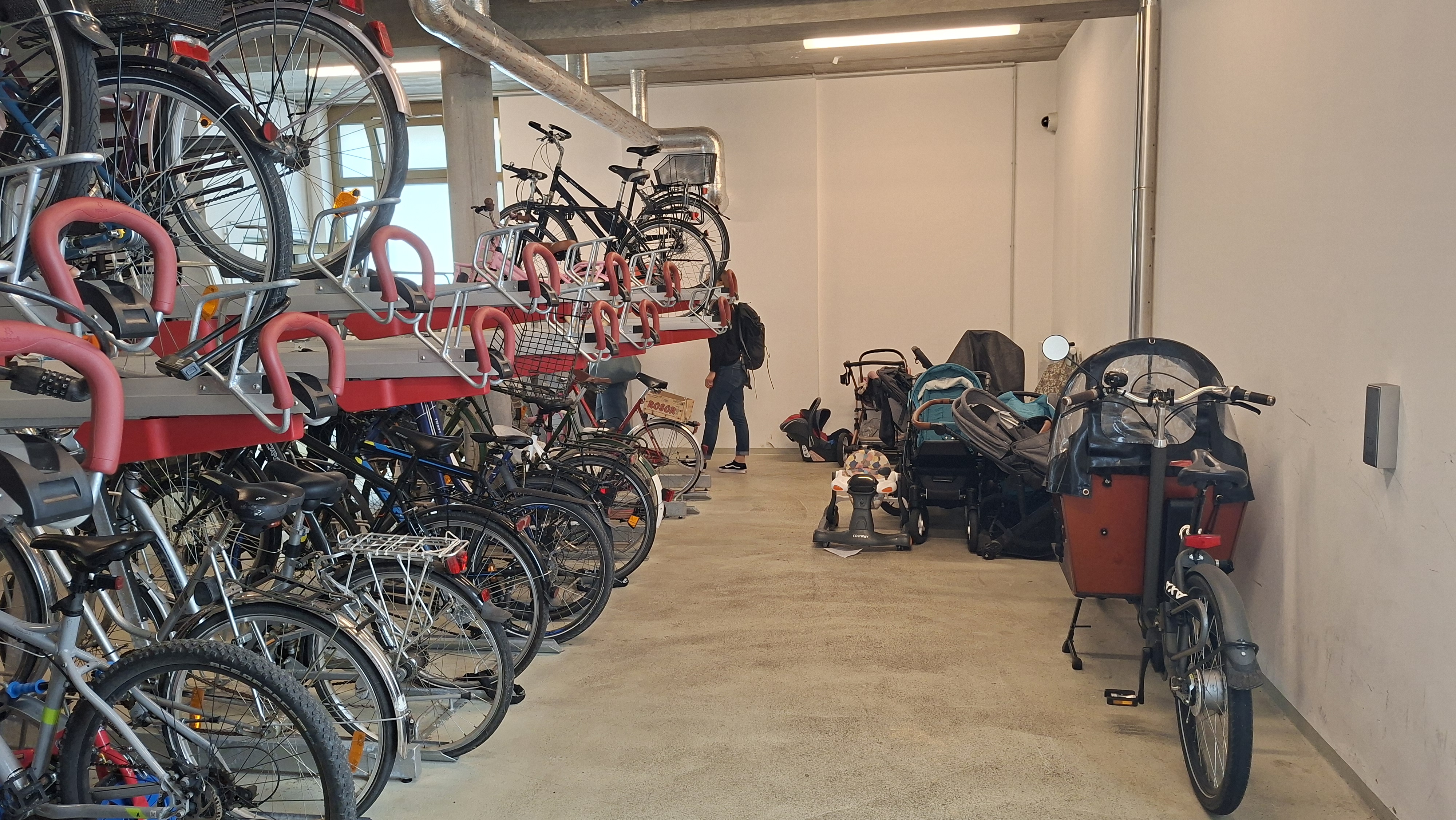
At a first glance there is a lot of space for different sorts of bikes, but let us take it to the test
The Question: Would you be able to park your standard bike on the upper row in the end of this room?
The answer is: No, you would not. Strollers and buggies are blocking the upper section of the double decker bike rack, making it impossible to park or retrieve a bike.
The solution: Architects and planners also need to take into account space for child transport vehicles and cargo bikes. If they do not, these larger bikes will end up being parked in ways that block pathways and access points.
An additional note:
Double decker bike parking solutions are popular, but they come with limitations that affect many riders. Not everyone can use the upper tier, and sometimes even the lower tier is difficult to access, especially if a bike has a child seat, a cargo box, or simply does not fit standard dimensions. If you decide to install double decker parking, there are a few important considerations to keep in mind:
Sufficient ceiling height: Make sure there is enough vertical clearance to accommodate larger bikes on the upper tier.
Full-length sliding rails: The pull-out or sliding mechanisms must extend all the way to the floor so bikes can be easily rolled onto the racks.
Weight and maneuverability: Upper racks should be easy to lift and stable enough for heavier bikes, including e-bikes, and pedelecs.
Accessibility for all users: Consider that children, older riders, or those with limited strength may struggle with upper-tier racks. Make extra offers for these target groups AND communicate them accordingly.
Space between racks: Ensure enough distance between the upper and lower levels so that handlebars, child seats, or panniers do not interfere with parking.
Clear signage and instructions: Simple guidance helps first time users understand how to safely use the system.
Include options to lock the frame not only the tire: Users need to be able to lock the frame of their bike without having to lean into the rack and get stuck between the already parked bikes. Providing additional metal bars or anchors to easily lock the bike frame (and not just the wheels) is both practical and necessary. This ensures the bike is truly secure and reduces the risk of theft.
By carefully addressing these factors, double decker bike parking can be a practical solution without excluding many riders. Yet, not all bikes will fit in these racks and not all people can use them. It is therefore always important to provide additional space and alternative parking options for cargo bikes, bikes with child seats, e-bikes, and other non-standard or special-needs bicycles.
Cargo bike parking without problems?
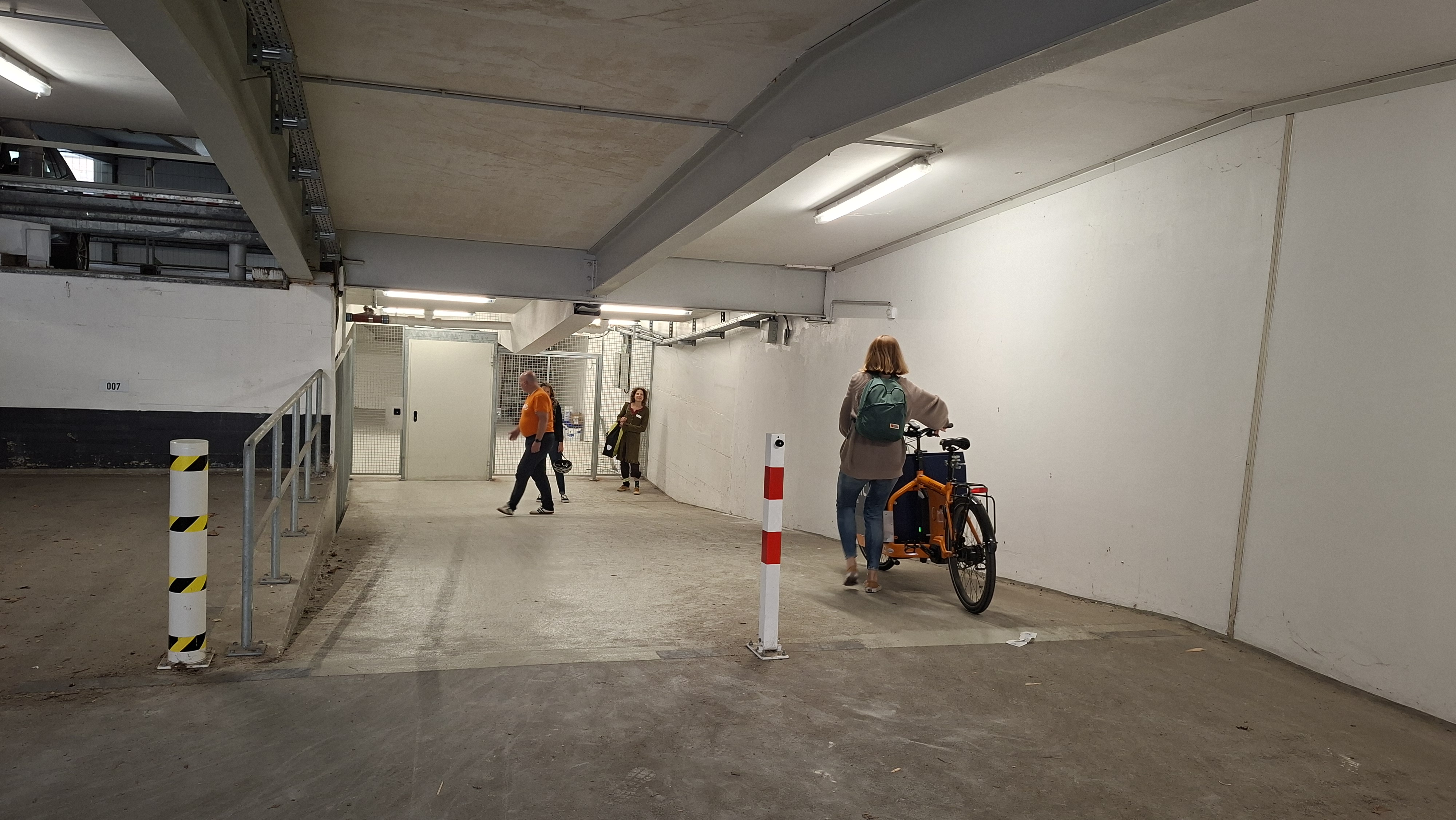
Basement or underground parking for cargo-bikes...is a lot of space enough?
The Question: Would you be able to easily park your cargo bike here?
The answer is: No, you would not. The parking facility lies behind a closed door. As you descend a rather steep ramp, you need to hold on to your cargo bike while constantly pressing the brake. The door opens towards you, which means you would have to prop up your cargo bike... which is impossible on such a slope and, on top of that, the door has to be opened manually, as it is not automated.
The solution: Access for cargo bikes can be more complicated than it seems. These bikes are heavy, have a wide turning radius, and cannot fit into standard racks. They need specially designed parking to stay safe and secure. By addressing these needs from the start, new real estate developments can create spaces that are not only functional but truly inclusive, welcoming every resident, visitor, and their bike.
Easy and safe access: Avoid steep ramps, use gentle slopes (max 6%) or level entrances wherever possible.
Automated or sliding doors: Doors that open automatically or slide sideways reduce the risk of accidents and make entry easier for heavy cargo bikes.
Sufficient space for maneuvering: Ensure wide access paths and turning space for bikes with long wheelbases, child seats, or cargo attachments.
Secure and appropriate racks: Provide racks that allow locking the bike frame, not just the wheel, and consider special racks for cargo bikes and e-bikes.
Alternative parking options: Offer additional spaces for bikes that do not fit standard racks, like cargo bikes, bikes with child seats, and other non-standard or special-needs bicycles.
Inclusive planning from the start: Integrate these considerations into the design of new developments to create truly functional, safe, and inclusive spaces for all residents and visitors.
An Additional Note: More and more families are choosing cargo bikes over private cars for daily commutes and errands. At the same time, demographic changes mean that residents who can cycle on a standard bike today may need specialised bikes in a few years to maintain their cycling habits. Good cargo bike parking should anticipate these needs, providing accessible, secure, and flexible facilities not only in residential developments but across all types of real estate projects.
By thinking ahead, planners can ensure that cycling remains a practical, safe, and enjoyable option for everyone and also offer parking solutions for non-standard bikes. This will cater to the needs of changing habits and demographic change, both for younger families and also for the elderly.
And what about bike boxes?
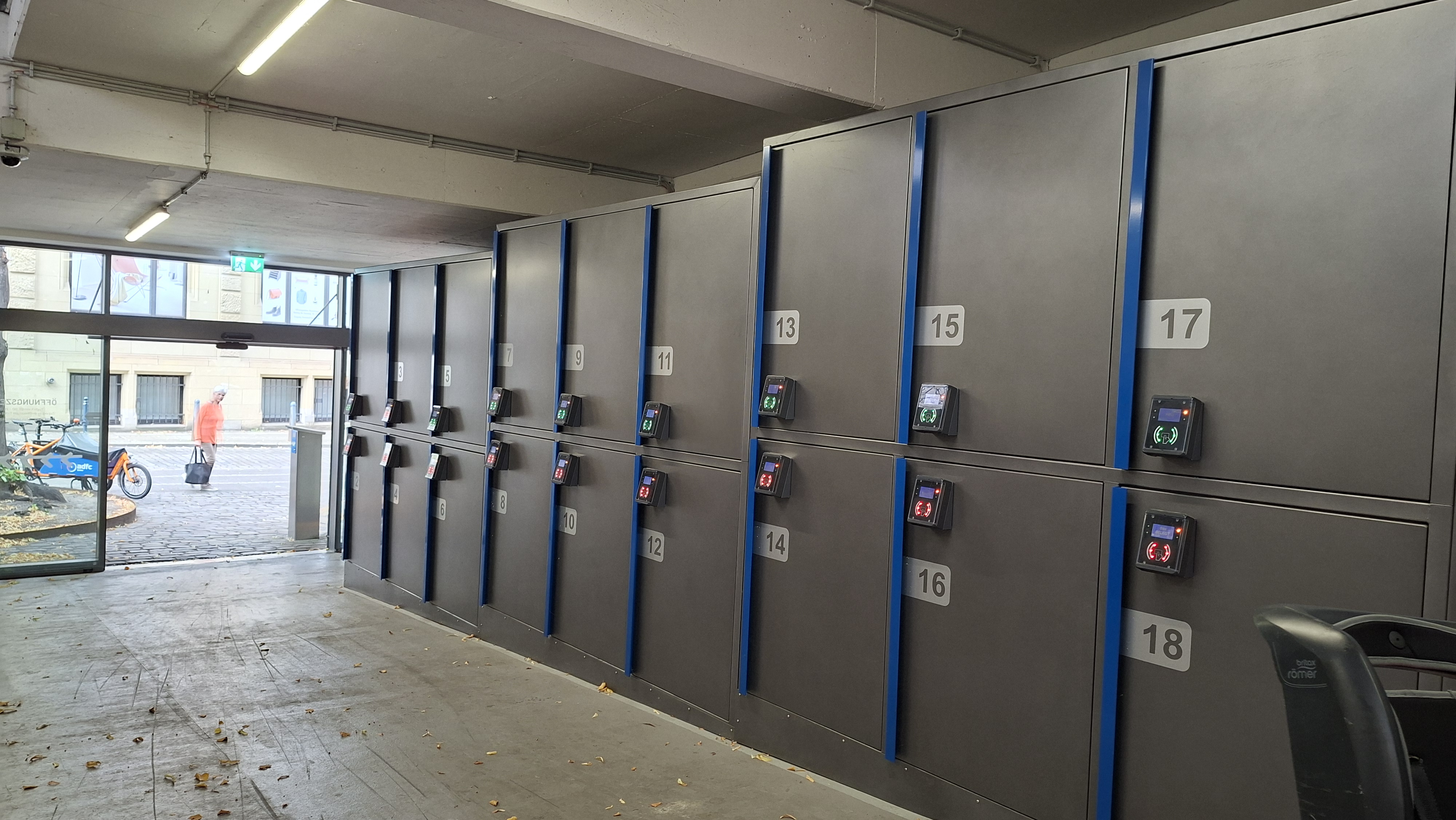
Bike boxes are safe options for e-bikes and pedelecs
The Question: What do you notice in this picture?
The Answer: Yes, correct: all the boxes in the bottom row are occupied, while the upper row remains empty. A user told us that parking a pedelec in an upper box is very difficult because the pull-out sliding mechanism does not reach all the way to the ground. Lifting a heavy pedelec into the upper box is therefore a real hassle.
The Solution: This rings a bell? Just as discussed above, accessibility for heavier bikes, like e-bikes and pedelecs must also be considered from the start when installing bike boxes. Full-length sliding rails that reach the floor, combined with sufficient space and appropriate support for lifting, can make upper-row parking practical for everyone.
Is communication and visibility important?
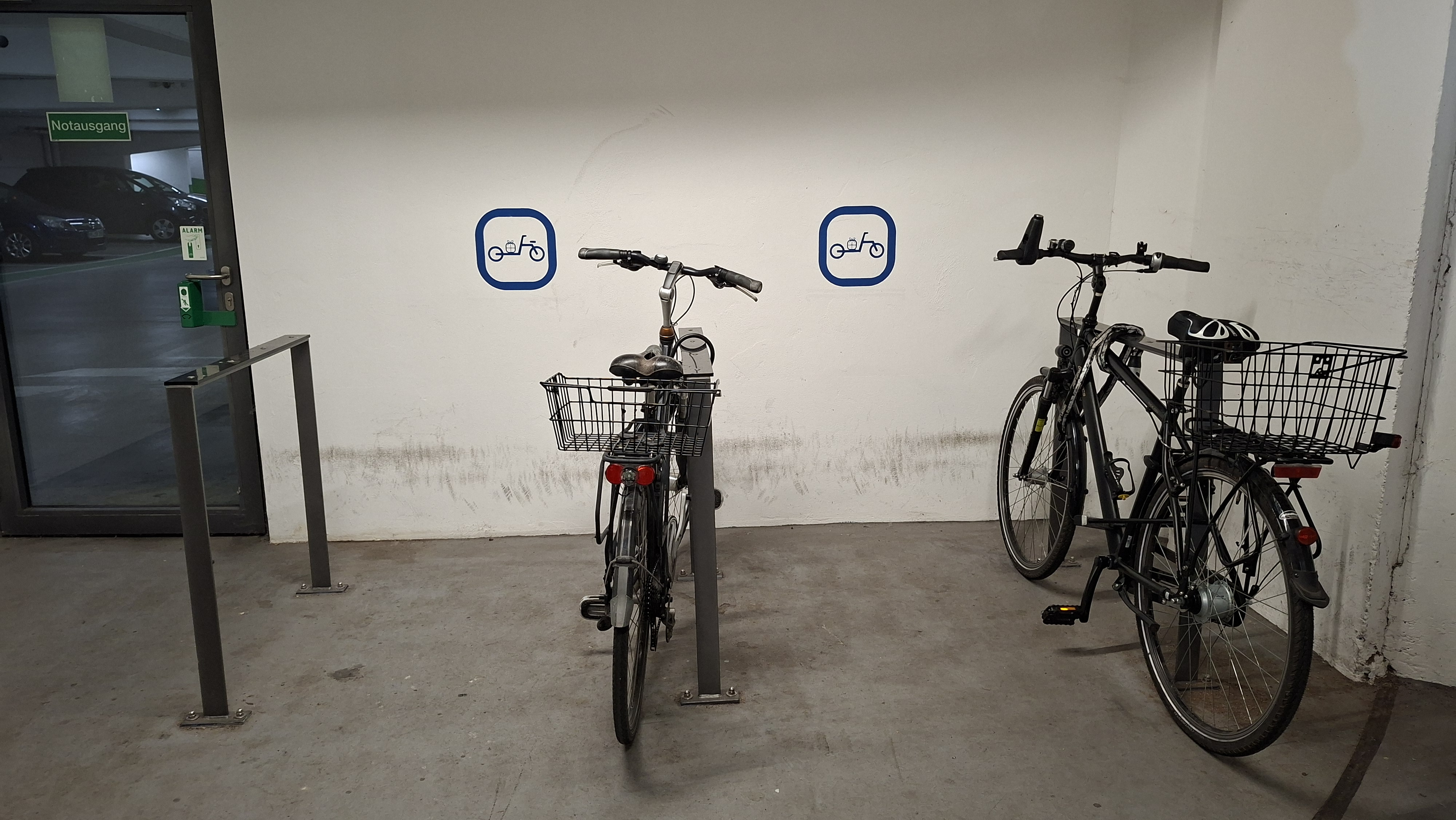
Oh great indoor bike parking, safe and dry...but wait?
The Question: Are the right types of bikes parked in this space?
The Answer: No, they are not. These parking spaces are intended for cargo bikes, yet standard bikes are occupying them. Why does this happen? Firstly, these standard bike racks are often easier to use for standard bikes and feel safer than the -in this case- provided double decker parking option. Secondly, communication about which bikes are allowed in these spaces is insufficient, leaving users unsure or unaware.
The Solution: To ensure cargo bike spaces are used correctly, a combination of design and clear communication is needed:
Optimised racks: Provide bike racks that accommodate the weight, length, and turning radius of cargo bikes. These racks should allow secure locking of the bike frame, have enough spacing between bikes, and be easy to use without lifting or awkward maneuvers.
Clear signage: Mark cargo bike parking with visual cues such as floor graphics, signs, or icons. Especially floor graphics are very effective, as they clearly mark the space where the bike has to park.
Education and guidance: Inform residents and visitors about the intended use of these spaces through onboarding materials, posters, or digital apps. Highlighting why cargo bike users need specific parking helps reduce misuse.
Accessibility considerations: Ensure racks are at a comfortable height, provide sliding rails if needed, and leave enough space for maneuvering even for heavier or longer bikes.
Monitoring and feedback: Periodically check usage and gather feedback to adjust rack placement, signage, or accessibility features, ensuring the parking spaces remain functional and inclusive.
An Additional Note: Properly designed and communicated cargo bike parking is crucial. Spaces that are difficult to use or unclear in purpose often remain underutilised, undermining efforts to promote sustainable mobility. By combining user friendly design with clear guidance, real estate developments can create bike parking that is both practical and inclusive for all types of cyclists.
What should be avoided at any cost?
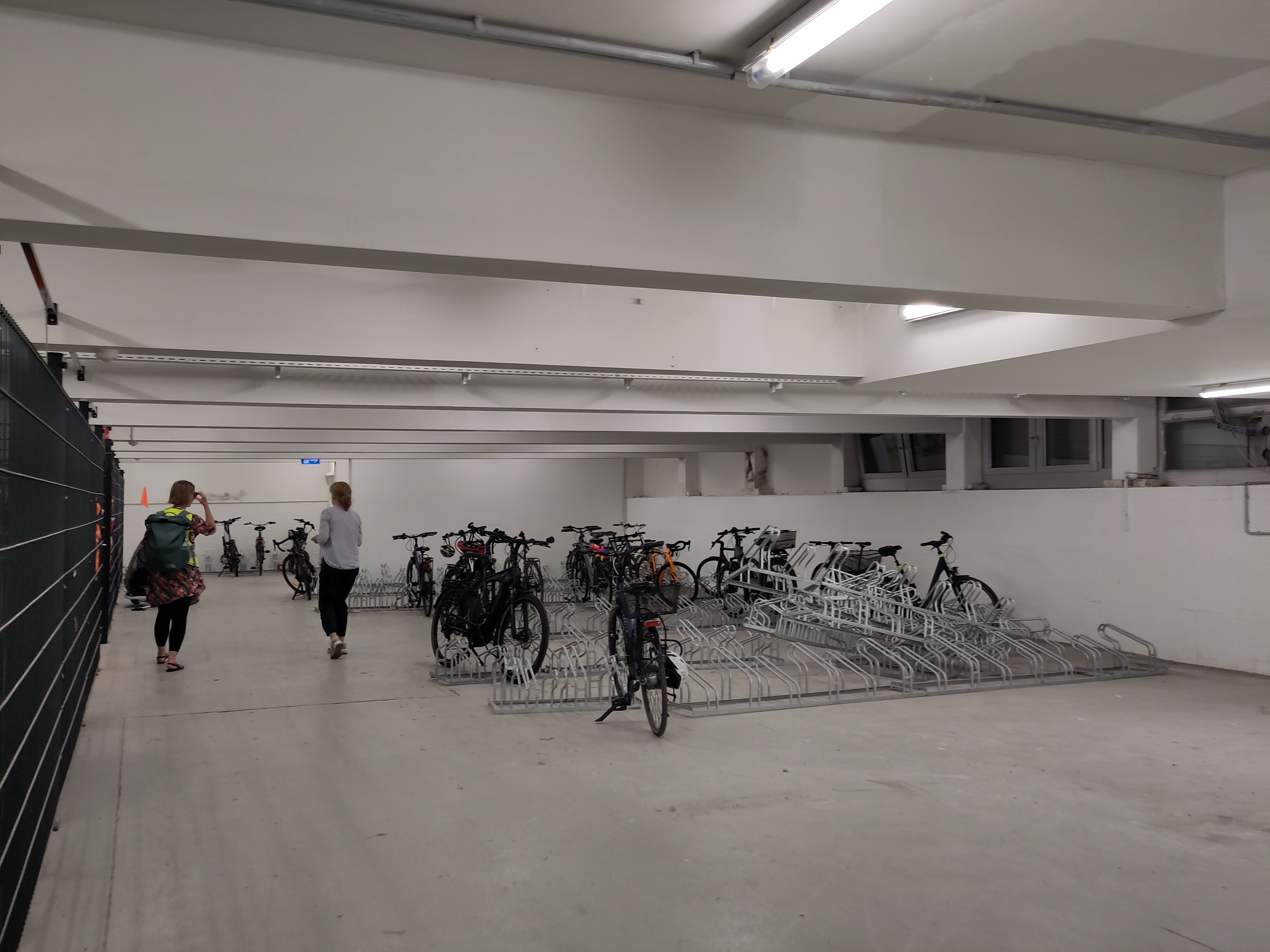
A lot of bike parking. Great, right!?
The Question: Which type of bike rack should be avoided at any cost and what should be done instead?
The Answer: Yes, that is correct: rim-clamping racks are the worst option if you want to create safe, secure, and user friendly bike parking. Because of the lever effect, wheels are easily bent or damaged. These racks do not allow the bike frame to be securely locked, and even locking the wheel can be awkward and inconvenient as users are prone to getting tangled with neighboring bikes, making the parking experience frustrating and inefficient.
The Solution: Rim-clamping racks should never be installed. Instead, always opt for safer, more practical solutions that accommodate a wide range of bikes, including cargo bikes and e-bikes such as:
Frame-supporting racks with a central bar:
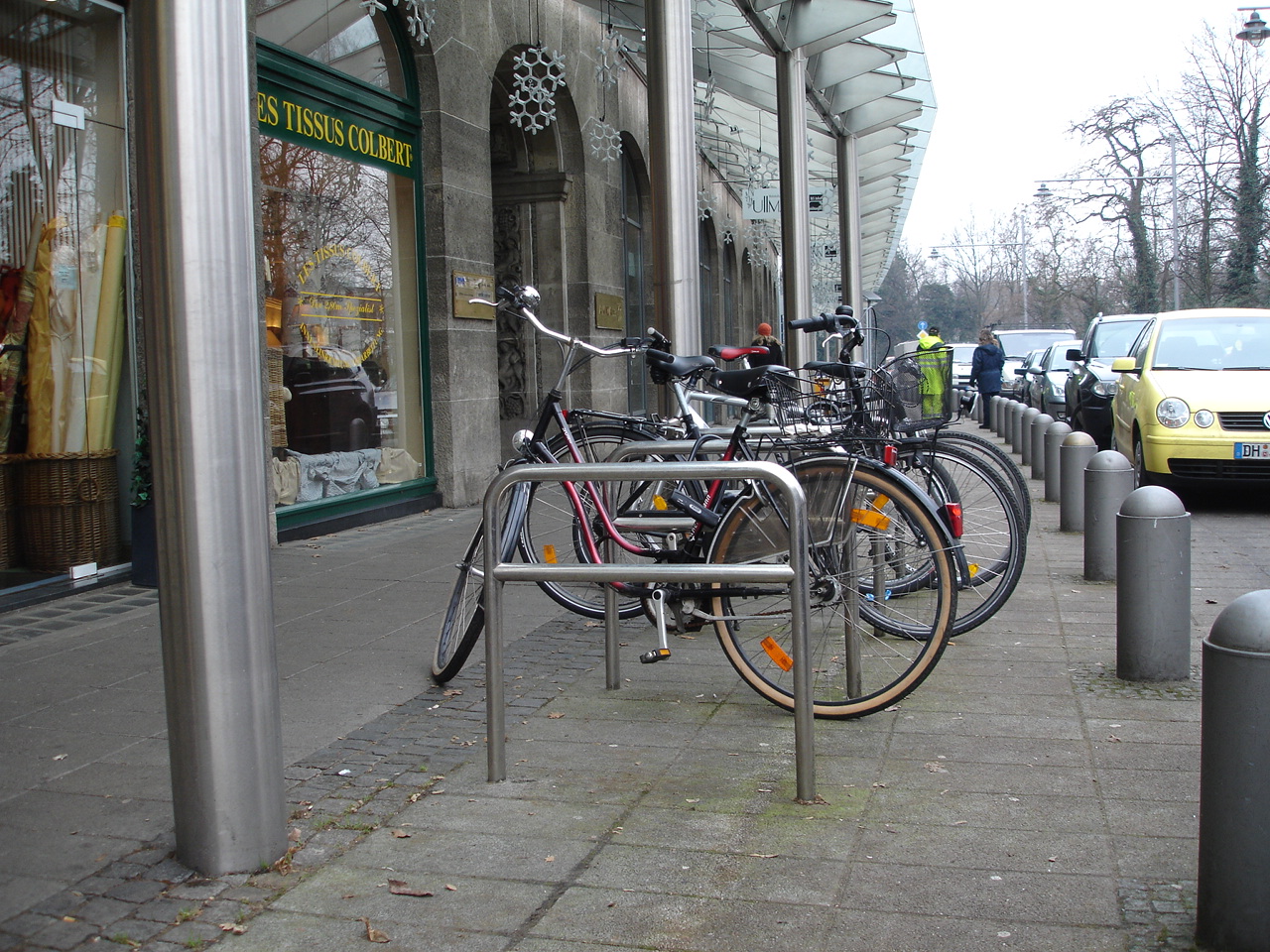
An additional note for good bike parking: Architects and planners should keep these guidelines in mind:
Enable user-friendly and bike-friendly parking: Make it easy for all riders to park their bikes without stress or unnecessary lifting, and ensure the design protects the bike from damage.
Ensure stability and proper positioning of parked bikes: Provide racks and supports that keep bikes upright and secure, preventing them from tipping over or colliding with neighboring bikes.
Guarantee theft protection: Design parking facilities so that bikes can be securely locked, ideally at the frame, to minimise the risk of theft.
What have we learned?
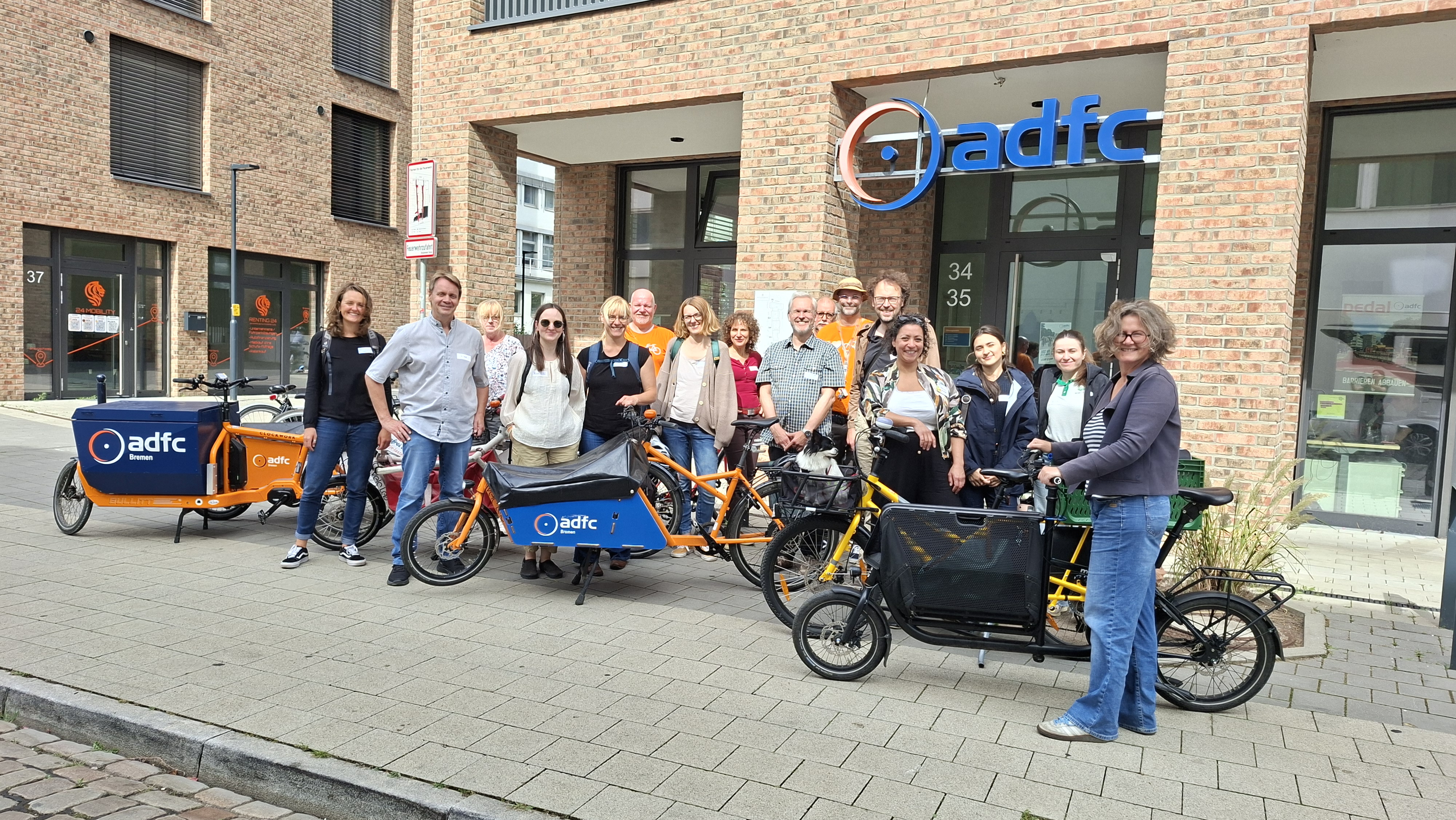
On our way unlocking the secrets of good bike parking!
There is no one-size-fits-all solution!
Bike parking must always be user oriented and tailored to the location. It is not just about the duration of stay, but also the types of bicycles, the needs of the users, and the character of the building or environment.
In short, good bike parking is:
Easily accessible
Visible and secure
Diverse and service oriented
If we want more people to choose cycling, we must also improve parking facilities. Bikes are becoming more expensive, and people’s needs are increasingly diverse – we need to plan accordingly.
Good bike parking is a key element for sustainable and future-proof urban development and mobility.
Credits
Written by Cornelia Cordes (Free Hanseatic City of Bremen)
Pictures by Cornelia Cordes (Free Hanseatic City of Bremen)
Edited by Jelten Baguet (Mpact)
Special Thanks to our colleagues Sven Eckert and Stephan Glinka (ADFC Bremen) and Kristin Kerstein (Chamber of Architects Bremen)
